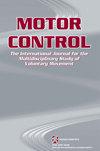Addition of a Cognitive Task During Walking Alters Lower Body Muscle Activity.
IF 1.4
4区 医学
Q4 NEUROSCIENCES
引用次数: 0
Abstract
This study compared electromyography of five leg muscles during a single walking task (WALK) to a dual task (walking + cognitive task; COG) in 40 individuals (20 M and 20 F) using a wavelet analysis technique. It was hypothesized that muscle activation during the dual task would differ significantly from the walking task with respect to both timing (H1) and frequency (H2). The mean overall intensity for the COG trials was 4.1% lower for the tibialis anterior and 5.5% higher for the gastrocnemius medialis than in the WALK trials. The changes between the WALK and COG trials were short 50 ms bursts that occurred within 100 ms of heel strike in the tibialis anterior, and longer activation periods during the stance phase in the gastrocnemius medialis. No changes in overall intensity were observed in the peroneus longus, gastrocnemius lateralis, or soleus. Furthermore, no clear frequency bands within the signal could further characterize the overall changes in muscle activity during the COG task. This advances our understanding of how the division of attentional resources affects muscle activity in a healthy population of adults.行走过程中增加认知任务会改变下半身肌肉活动。
这项研究比较了在单一行走任务(WALK)和双重任务(行走+认知任务;利用小波分析技术对40个个体(20 M和20 F)的COG进行了分析。假设双重任务中的肌肉激活在时间(H1)和频率(H2)方面与步行任务有显著差异。与WALK试验相比,COG试验中胫骨前肌的平均总强度低4.1%,腓肠肌内侧肌的平均总强度高5.5%。WALK和COG试验之间的变化是胫骨前肌在脚跟撞击100毫秒内的短50毫秒爆发,而腓肠肌内侧肌在站立阶段的激活时间更长。腓骨长肌、腓肠肌外侧肌或比目鱼肌的总强度未见变化。此外,信号中没有清晰的频带可以进一步表征COG任务期间肌肉活动的整体变化。这促进了我们对注意力资源分配如何影响健康成年人肌肉活动的理解。
本文章由计算机程序翻译,如有差异,请以英文原文为准。
求助全文
约1分钟内获得全文
求助全文
来源期刊

Motor Control
医学-神经科学
CiteScore
1.80
自引率
9.10%
发文量
48
审稿时长
>12 weeks
期刊介绍:
Motor Control (MC), a peer-reviewed journal, provides a multidisciplinary examination of human movement across the lifespan. To keep you abreast of current developments in the field of motor control, it offers timely coverage of important topics, including issues related to motor disorders. This international journal publishes many types of research papers, from clinical experimental to modeling and theoretical studies. These papers come from such varied disciplines as biomechanics, kinesiology, neurophysiology, neuroscience, psychology, physical medicine, and rehabilitation.
Motor Control, the official journal of the International Society of Motor Control, is designed to provide a multidisciplinary forum for the exchange of scientific information on the control of human movement across the lifespan, including issues related to motor disorders.
Motor Control encourages submission of papers from a variety of disciplines including, but not limited to, biomechanics, kinesiology, neurophysiology, neuroscience, psychology, physical medicine, and rehabilitation. This peer-reviewed journal publishes a wide variety of types of research papers including clinical experimental, modeling, and theoretical studies. To be considered for publication, papers should clearly demonstrate a contribution to the understanding of control of movement.
In addition to publishing research papers, Motor Control publishes review articles, quick communications, commentaries, target articles, and book reviews. When warranted, an entire issue may be devoted to a specific topic within the area of motor control.
 求助内容:
求助内容: 应助结果提醒方式:
应助结果提醒方式:


